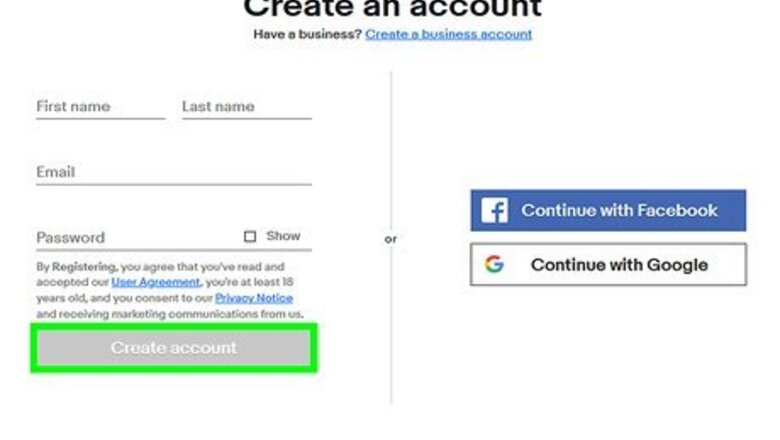
views
Creating a Seller Account
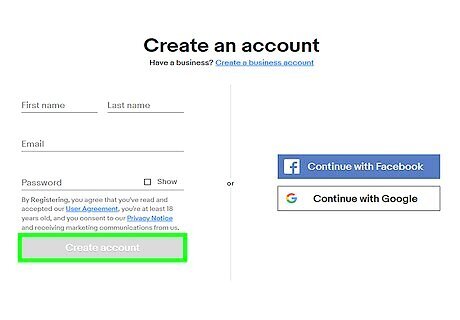
Sign up for an account on eBay. To begin selling on eBay, you first need to make an account. If you have ever bought something on eBay, then you already have one. You don’t need to take any additional steps to turn it into a seller’s account. However, take time to fill out your account profile, such as by selecting any payment options you plan on using. Making an account is simple. You will need to sign up using your name and email address so you can keep track of your listings. Once you have an account, click the “Sell” button at the top of the page when you’re ready to list your coins. Alternatively, go to https://www.ebay.com/sl/sell.

Read about the fees eBay charges for sales. As a seller, you get to list up to 50 items per month for free. After that, you have to pay a listing fee of $0.35 USD. The main charge comes from the closing fee, since eBay takes a commission of 10% off of whatever you sell. The closing fee depends on how much your coins sell for. Keep in mind that whatever payment service you choose will likely have fees too. PayPal, for example, charges a fee of 2.9% plus $0.30 on the final selling price. Some areas also have a sales tax, which is collected automatically when a buyer pays for your coins. The sales tax depends on the laws where you live, but you can have buyers cover this cost.
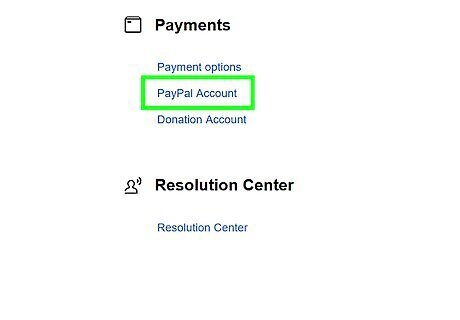
Set up a payment account to receive money from your sales. The easiest way to send and receive a payment is through PayPal. PayPal is owned by eBay, so it is well-integrated into the site. It allows customers to pay you directly using their own payment account or a linked payment method, such as a bank account, credit, or debit card. Link your payment account by going to your profile page on eBay. You could also have buyers pay through a credit or debit card. To do this, you need to set up a merchant account. It’s worth considering if you plan on selling lots of coins or running a storefront.

Generate some positive feedback to increase your sales. Your feedback rating is an important part of selling coins successfully. Most buyers will look at your rating before making a purchase. To increase your rating, make a few purchases on eBay or sell your least valuable coins first. The other person may then leave a star rating with feedback that can improve your ability to sell coins. There are fake coins sold on eBay, so buyers often hesitate when dealing with new accounts. If you have a positive reputation with a high number of ratings, people will be more likely to buy from you. The rating system includes the accuracy of the item description, how good the communication was, how quickly the item was received, and how reasonable the cost was.
Listing Coins for Sale
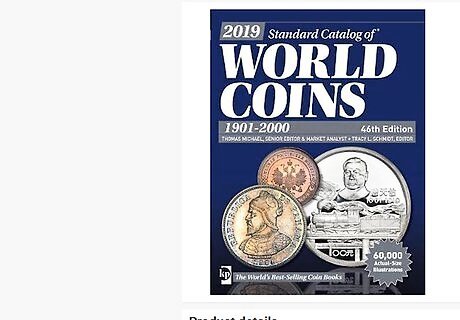
Identify the coin you want to sell. You can’t accurately list a coin for sale unless you know what it is. If you don’t know what coin you have, start by checking the date, mint mark, and other noticeable details. Try using a book like the Standard Catalog of World Coins to get an idea of what you have. Also, post to a coin group online or ask a dealer if you need assistance. Another way to get accustomed to selling is by searching auctions for similar coins. Compare the listed coins to yours and see how much people pay for them.

Grade the coin to find out how much it is worth. Grading is a way to put a value on a coin by examining its appearance. A coin’s value is determined by its appearance and is lessened by damage. To estimate a coin’s value on your own, purchase a guidebook or look up grading guides online. You could also take the coin to a professional grader for a more accurate estimate. For example, use the Official ANA Grading Standards for United States Coins to grade American coins. If you suspect a coin is valuable, such as worth more than $200, contact a service like the Professional Coin Grading Service (PCGS). They provide an official grade you can use when advertising the coin for sale.
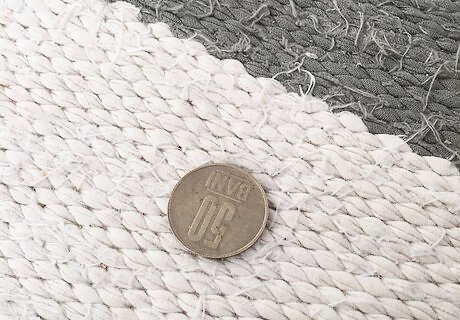
Take clear, accurate photos of the coins you plan on selling. You get room to display 12 photos for free with each eBay listing you create. Take advantage of this by showing off a coin from different angles. Get good pictures of the front and back of the coin, but don’t neglect the ridges and other small details. Make sure the pictures provide an accurate display of what customers can expect to get should they buy your coins. Taking pictures on a phone is fine, but consider borrowing a decent camera. It can lead to higher quality pictures that improve your chances of completing a sale. Take clear pictures in decent lighting. Show off scratches, discolorations, and other signs of damage.

Write an accurate description about each coin you’re selling. Give a little background information about the coin. Start out with the name the coin is known by, then mention when and where it was minted. Describe the appearance of the coin as well as any damage you spot. Be as accurate and honest as possible. For example, you might write, “1909 wheat penny with no mint mark. It has a dark coloring on the reverse and a small scratch on the president’s cheek.” Buyers look for accurate descriptions to ensure the coin isn’t counterfeit. If you had it professionally graded, list that as well to add more authenticity to the description.
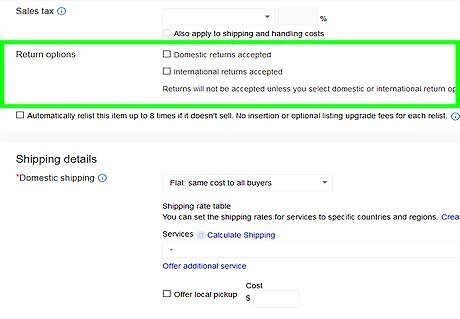
Clarify your return policy in the description. Mention that you don’t accept returns if you want all sales to be final. By not accepting returns, you prevent buyers from sending back damaged or counterfeit coins. If you wish to take returns, offer a 30-day window after the purchase is finalized. Explain that the buyer has to pay to pack and ship the coin on their own. Reduce the possibility of return requests by advertising your coins accurately. Clear pictures and descriptions go a long way toward customer satisfaction. Keep in mind that the return policy isn’t an excuse to sell counterfeit or falsely-advertised coins. The buyer can raise a complaint with eBay to get their money back.
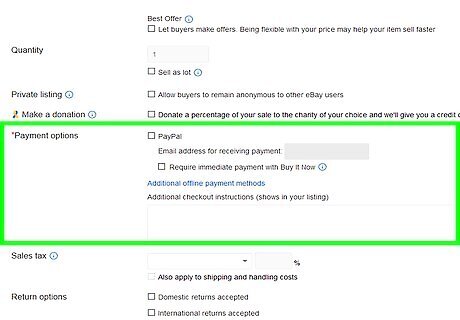
List the ways you plan on accepting payment. Clarify how you intend on closing the sale. Normally, this is done through eBay’s payment platform, PayPal. If you set up a merchant gateway to accept credit or debit cards, let the buyer know. The payment options display on each listing you post. PayPal is typically the best way to complete a transaction since it’s official and protects both buyers and sellers against scams. An unusual way to complete a transaction is by requesting payment on pickup. In case a buyer lives near you, you could deliver the coin to them. However, you should still ask for PayPal or a credit or debit card to avoid scams.

Select a shipping cost you’re willing to pay. When you post coins for sale, eBay calculates the shipping for you. You have a choice between offering a flat shipping fee or one that varies depending on the buyer’s location. The best option depends on how much the coin is worth. For more valuable coins, such as those over $200, plan on making the buyer pay for insured shipping. For low-value coins, consider choosing a free shipping option. You will have to pay for the shipping yourself, but it’s a good way to draw attention to your listings. You could also charge a little extra for your coins to cover the shipping fee. For mid-range coins up to about $200, try selecting a standard economy shipping with the post office or another carrier. Look for an insured registered mail option for more valuable coins. Note that international shipping charges can be a big problem if you choose free or flat rate shipping. Fortunately, eBay allows you to choose which areas you are willing to ship to.
Completing a Sale

Set up an auction to let people bid on your coins. Bidding is the system eBay is known for and it can be risky to use if you’re not used to it. Select a reasonable minimum price for your coins, then wait for people to bid on them. Try setting the coin at a price that is a little less than what you hope to receive. If the price is good and people spot your listing, you may soon see the bids start rolling in. Many listings don’t get bids. This could be because your price is too high, nobody saw the listing, or a number of other reasons. You have to pay the listing fee even when a coin doesn’t sell. This could become a problem if you plan on listing more than 50 coins a month. Auctions are a gamble. Sometimes coins get less attention than you expect, and sometimes a fierce bidding war drives the price up more than you expect. However, you can relist a coin that doesn’t sell.

Use fixed price listings to keep coins on sale long-term. Set the price, then wait indefinitely until the coin sells. Your listing will have a big “buy it now” button customers can click to make a purchase. It takes less risk and maintenance than an auction listing. However, due to the number of listings, it also doesn’t attract as much attention. People may hesitate to check out fixed price listings. Auctions are useful since you can set the price low and watch people bid it back up. The bidding process often makes them think they’re going to get a better deal. Fixed price listings are very safe, so consider using them for valuable coins you don’t want to negotiate on. Just be patient if the coin doesn’t sell right away. Fixed price listings are also useful if you run a store on eBay, since you could list all your coins for sale on your storefront and handle purchases as they come in.

Wait for a buyer to pay for a coin you listed. Monitor your auctions or wait for someone to buy from a listing. You will receive a message from eBay through your account and through email. Don’t rush to ship the coin. Check for a second message explaining that the transaction has been completed and the funds have been deposited into your seller account. If you don’t get a notification after a few days, contact the buyer to discuss payment. Make sure they plan on paying before you mail them anything.

Pack the coin to protect it from damage during shipping. Put the coin into a non-PVC coin flip or cardboard holder. Also, drop it into a plastic bag to guard against moisture damage. Then, wrap the coin in bubble wrap and stick it into a padded envelope. Finish by sticking a label to the front of the envelope. To save money on shipping material, purchase envelopes and bubble wrap from shipping or office supply stores. Then, print the label at home through your eBay account. Pack the envelope as much as you can to prevent the coin from moving. Although coins are made to last, scratches and discolorations affect their value.

Purchase shipping insurance before sending the package. Shipping insurance is necessary for protecting valuable coins in case they get lost, stolen, or damaged. Consider looking into insurance options for any sale over $20. Generally, a basic shipping option with insurance covers up to $50. Purchase additional coverage for any coins worth $200 or more. Insurance is great in case of an emergency that could lead to a returned product. Most of the time, you won’t use it, but it is useful to have in case you need it. Most shipping companies offer insurance for coins. You could also look for a third-party insurance company that covers coins.




















Comments
0 comment